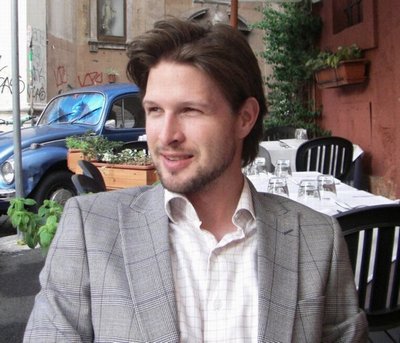October 30, 2008
A look behind the veil at sexuality in Islam — second of four in the Centennial Lecture Series
Two images seem to compete when westerners think of sexuality in the Islamic world — belly dancers and harems on the one hand and shrouds and restrained, even repressed sexuality on the other. But which view is closer to the truth?
Oddly, both are true in their way, says Jonathan A.C. Brown, assistant professor of Arab and Islamic studies in the UW Department of Near Eastern Languages and Civilization. But he stressed that it’s wrong to assume that the world’s 1.3 billion-plus Muslims all believe or behave as one.
“The idea that Islam is this or does that is inaccurate,” Brown said. “It’s not one big unit that does things as a unit … (Muslims) do a lot of different things and believe a lot of different things.”
Brown will deliver a lecture titled Islam and Sexuality: Beyond the Headlines from 7 to 9 p.m. Wednesday, Nov. 5, in 120 Kane. The lecture is the second in “The Centennial Series: Beyond the American Point of View,” and is presented by the College of Arts & Sciences and the UW Alumni Association. The series celebrates the beginning of the centennial year for four campus units — Near Eastern Languages and Civilization, Scandinavian Studies, Asian Languages and Literature and the Jackson School of International Studies.
Those dual notions of sexuality in Islam both have elements of truth, Brown said. Sexual pleasure is considered healthy, an appetite to be indulged, in much of the Muslim world — far from the stereotype of Islam being strict, frigid and repressive — but only if the sex happens in a marriage.
“What Muslim scholars would say is that outside of marriage any kind of sexual contact is not permitted. It is very strict, and women are supposed to cover up.” But he added that while the wife is expected to be “demure” when among men or in mixed company, “at home, the sky’s the limit.”
Brown said westerners might be surprised to see how publicly some aspects of sex are discussed in Islamic societies. Noting that in his talk he’ll confine his remarks mostly to Egypt, Brown said sex manuals are sold on the sidewalk in Cairo and marital relations are even discussed in religious settings. He added that husbands and wives are required by Islamic law to sexually satisfy one another.
But are women repressed, by western standards, in the Islamic world? “Compared to American society, women are repressed in many parts of the world, it’s not something that’s unique to Islam,” Brown said. The Islamic tradition “clearly puts men in a leadership role in the family, and the wife is the junior partner — but it also says that this is not a matter of superior and inferior.” But he added that there’s no getting around the fact that in the Muslim world, men and women are seen as having different roles.
He added, “Modern female Islamic scholars writing about this stuff don’t express the desire to be equal. They simply want to be able to participate in the public sphere as men would.”
Brown’s lecture will be followed by two more in the Centennial Series.
• Christine Ingebritsen, professor of Scandinavian Studies, will speak on The Power of Scandinavia on Nov. 12. (This lecture is already full.)
• Michael Shapiro, professor and chair, and Zev Handel, professor, both of the Department of Asian Languages and Literature, will speak on A Fire Pot of Tongues: Asian Languages in a New Global Environment on Nov. 19.
Brown’s lecture marks the beginning of a centennial celebration for the Department of Near Eastern Languages and Civilization. That’s because it traces its roots to the days of the Alaska-Yukon-Pacific Exposition. It was in 1909 that the Rev. Herbert H. Gowen, then of the Department of Oriental Subjects, gave a lecture that promoted international studies at the UW.
The Department of Near Eastern Languages and Civilization became a department on its own in 1970. Scott Noegel, department chair, said in a statement on the department Web site that as the many nations of the area continue to play pivotal roles on the world stage, “the need for firm knowledge about Near Eastern languages and cultures becomes increasingly clear” and added, “These languages and cultures are our specialty.”
Noegel continued, “Indeed, in NELC one can find experts in Arabic, Hebrew (ancient and modern), Persian, Turkish, Egyptian (hieroglyphic and Coptic), and the languages of Central Asia. Our courses offer great breadth, in terms of the number of different languages taught, and great depth, in terms of the historical range our courses cover (from ancient to medieval to modern periods). As faculty, we proudly inspire a new generation of citizens informed about the Near East and Central Asia.”
The department is planning a number of events throughout the year to mark the milestone. These include:
• January 21, 2009: Thomas Schnieder, University of British Columbia, Egyptology in the Nazi Era. 6:30 p.m., 226 Communications.
• April 16, 2009: Chloe Ragazzoli, University of the Sorbonne, Paris, When Scribes Pass By: Visitors’ Graffiti in Ancient Egypt. 6:30 p.m., 226 Communications.
• April 22, 2009: Shibley Telhami, University of Maryland, Farhat J. Ziadeh Distinguished Lecture in Arab and Islamic Studies. 7 p.m., Henry Art Gallery Auditorium.

